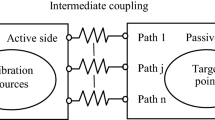Abstract
The excitation force of a powertrain is one of major sources of interior noise in a vehicle. This paper presents a novel approach to predict the interior noise caused by the vibration of the powertrain by using the hybrid TPA (transfer path analysis) method. Although the traditional transfer path analysis (TPA) is useful for the identification of powertrain noise sources, it is difficult to modify the structure of a powertrain by using experiments for the reduction of vibration and noise. In order to solve this problem, the vibration of the powertrain in a vehicle is numerically analyzed by using the finite element method (FEM). The vibration of the other parts of the vehicle is investigated by using experiments based on vibrato-acoustic transfer function (VATF) analysis. These two methods are combined for the prediction of interior noise caused by a powertrain. Throughout this research, two papers are presented. This paper presents a simulation of the excitation force of the powertrain exciting the vehicle body based on numerical simulation. The other paper presents a prediction of interior noise based on the hybrid TPA, which uses the VATF of the car body and the excitation force predicted in this paper.
Similar content being viewed by others
References
Auweraer, H. V., Mas, P., Dom, S., Vecchio, A. Janssens, K. and Ponseele, P. (2007). Transfer path analysis in critical path of vehicle refinement: the role of fast, hybrid and operational path analysis. SAE Paper No. 2007-01-2352.
Blakely, K. (1991). Updating MSC/nastran models to match test data. Proc. MSC World Users Conf., 2, Paper No. 50.
Huegen, S., Warren, G., Menne, R., Wolschendorf, J., Schwaderlapp, M. and Schoenherr, C. (1997). A new 2.3L DOHC engine with balance shaft housing-step of refinement and optimization. SAE Paper No. 970-921.
Kim, S. J. and Lee, S. K. (2008). Prediction of interior noise caused by excitation force of powertrain based on hybrid transfer path analysis, Int. J. Automotive Technology 9,5, 577–583.
Kim, S. J., Lee, J. Y and Lee, S. K. (2007). Noise refinement of a vehicle by reduction of the axle gear whine noise based on structural modification using FEM and BEM. Int. J. Automotive Technology 8,5, 605–614.
Lalor, N. and Priebsch, H. H. (2007). The prediction of low-and mid-frequency internal road vehicle noise: a literature survey. Proc. Instn. Mech. Engrs.: Part D, 221,3, 245–269.
Lee, J. H., Lee, S. K., Kim, S. J. and Kim, T. Y. (2006). Analysis of excitation forces for the prediction of the vehicle interior noise by the powertrain. J. Korean Society of Noise and Vibration Engineer 16,12, 1244–1251.
Lee, S. K. (2004). Identification of a vibration transmission path is a vehicle by measuring vibrational power flow. Proc. Instn. Mech. Engrs.: Part D, 218,2, 167–175.
MSC/ADAMS (2005). Basic Full Simulation Package Training Guide. MSC. Software Corp. U.S.A.
MSC/PATRAN (2007). The World’s Leading CAE Modeling System. MSC. Software Corp. U.S.A.
Nakamura, H. (1976). A low vibration engine with unique count-balance shafts. SAE Paper No. 760111.
Pistek, V. and Novotny, P. (2005). Dynamics of in-line six-cylinder diesel engine with rubber damper. 23rd CADFEM Users’ Meeting 2005 Int, Cong, FEM Technology with ANSYS CFX & ICEM CFD Conf., Bonn, Germany.
Richard, C. (2001). CATIA V5 Workbook Release 6 & 7, Schroff Development Corp. U.S.A.
Sakai, T. and Sakamoto, A. (2003). Improvement of engine noise for the 2003 Accord using hybrid CAE technology. SAE Paper No. 2003-01-1427.
Seki, Y., Suzuki, T., Tsukahara, M. and Takahashi, Y. (2001). How to predict powertrain vibration at the engine mounting points under running conditions. SAE Paper No. 2001-01-1592.
Shung, H. S. and Donald J. N. (2001). Assessment of a vehicle concept finite-element model for predicting structural vibration. SAE Paper No. 2001-01-1402.
Taylor, C. F. (1968). The Internal Combustion in Theory and Practice. 2, MIT Press. U.S.A.
Walter, O., Kaiser, H. J. and Jurgen, M. (1990). Finite element analysis of dynamic behavior of an engine block and comparison with experimental modal test results. Proc. MSC World Users Conf., 1, Paper No. 14.
Winterer, S. and Bretl, J. (1993). Efficient design studies using eigensolution reanalysis. SAE Paper No. 931297.
Author information
Authors and Affiliations
Corresponding author
Rights and permissions
About this article
Cite this article
Kim, S.J., Kim, S.G., Oh, K.S. et al. Excitation force analysis of a powertrain based on CAE technology. Int.J Automot. Technol. 9, 703–711 (2008). https://doi.org/10.1007/s12239-008-0083-9
Received:
Revised:
Published:
Issue Date:
DOI: https://doi.org/10.1007/s12239-008-0083-9




